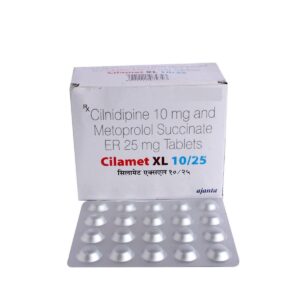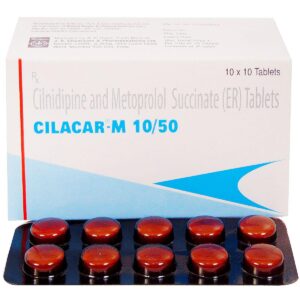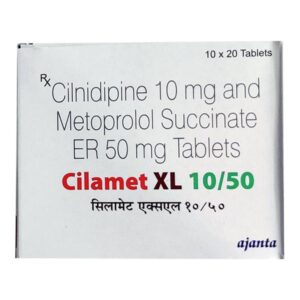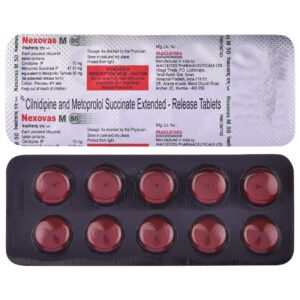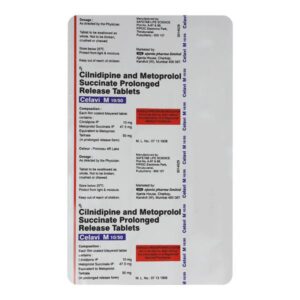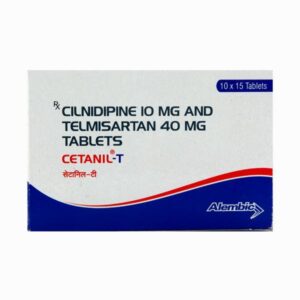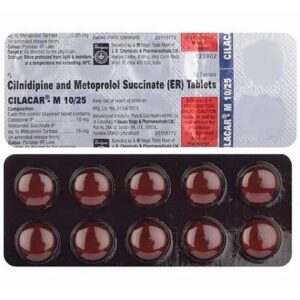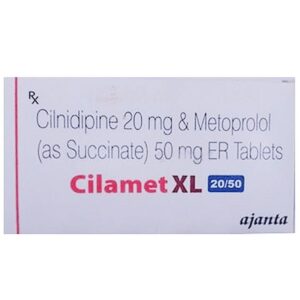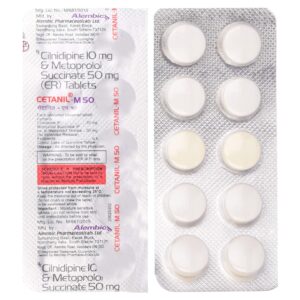METOPROLOL + CILNIDIPINE
Metoprolol: Metoprolol is a medication that belongs to a class of drugs known as beta-blockers. It is commonly prescribed for various cardiovascular conditions, including high blood pressure (hypertension), angina (chest pain), and heart failure.
The primary mechanism of action of metoprolol is to block the effects of adrenaline on beta receptors in the body. By doing so, it reduces the heart rate and blood pressure, thus decreasing the workload on the heart and improving its efficiency. It also helps to normalize irregular heart rhythms.
Metoprolol is available in various forms including immediate-release tablets, extended-release tablets, and injection.
The dosage of metoprolol depends on the specific condition being treated and the individual patient’s response. It is usually started at a low dose and gradually increased until the desired effect is achieved. The dose can range from 25 mg to 400 mg daily, depending on the severity of the condition.
As with any medication, metoprolol may cause side effects. Common side effects include fatigue, dizziness, lightheadedness, low blood pressure, slow heart rate, and cold hands or feet. It may also cause more serious side effects such as shortness of breath, swelling in the ankles or feet, mental/mood changes, and allergic reactions. It is essential to notify a healthcare professional if any severe or persistent side effects occur.
It is important to note that metoprolol should not be stopped suddenly without consulting a doctor, as this can lead to a worsening of the underlying condition or rebound effects.
Cilnidipine: Cilnidipine is a calcium channel blocker medication used primarily for the treatment of hypertension (high blood pressure). It is classified as a dihydropyridine calcium channel blocker but is unique due to its dual action mechanism.
The mechanism of action of Cilnidipine involves blocking the calcium channels in the smooth muscle of blood vessels. This action reduces the influx of calcium ions into the cells, leading to relaxation and dilation of the blood vessels. By doing so, it helps to reduce blood pressure by decreasing peripheral vascular resistance.
The recommended dose of Cilnidipine varies depending on the patient’s condition and response. Typically, the starting dose is 5 mg once daily, which can be increased to 10 mg daily if necessary. It is important to follow the dosage instructions provided by a healthcare professional.
As with any medication, Cilnidipine may cause certain side effects. Common side effects may include headache, dizziness, flushing, pedal edema (swelling of the feet and ankles), and palpitations. These side effects are usually mild and temporary. However, if any of these side effects persist or worsen, it is important to consult a healthcare professional.
Less common but potentially serious side effects of Cilnidipine may include chest pain, irregular heartbeat, shortness of breath, and severe dizziness. If a person experiences any of these side effects, immediate medical attention should be sought.
It is important to note that Cilnidipine should not be stopped abruptly without consulting a healthcare professional. Suddenly stopping the medication may lead to a rapid increase in blood pressure.
As with any medication, Cilnidipine may interact with other drugs, so it is important to inform a healthcare professional about all current medications, including over-the-counter drugs and supplements, before starting Cilnidipine.

